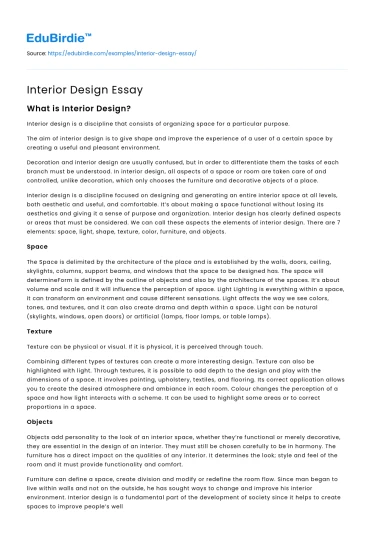What is Interior Design?
Interior design is a discipline that consists of organizing space for a particular purpose.
The aim of interior design is to give shape and improve the experience of a user of a certain space by creating a useful and pleasant environment.
Save your time!
We can take care of your essay
- Proper editing and formatting
- Free revision, title page, and bibliography
- Flexible prices and money-back guarantee
Decoration and interior design are usually confused, but in order to differentiate them the tasks of each branch must be understood. In interior design, all aspects of a space or room are taken care of and controlled, unlike decoration, which only chooses the furniture and decorative objects of a place.
Interior design is a discipline focused on designing and generating an entire interior space at all levels, both aesthetic and useful, and comfortable. It’s about making a space functional without losing its aesthetics and giving it a sense of purpose and organization. Interior design has clearly defined aspects or areas that must be considered. We can call these aspects the elements of interior design. There are 7 elements: space, light, shape, texture, color, furniture, and objects.
Space
The Space is delimited by the architecture of the place and is established by the walls, doors, ceiling, skylights, columns, support beams, and windows that the space to be designed has. The space will determineForm is defined by the outline of objects and also by the architecture of the spaces. It’s about volume and scale and it will influence the perception of space. Light Lighting is everything within a space, it can transform an environment and cause different sensations. Light affects the way we see colors, tones, and textures, and it can also create drama and depth within a space. Light can be natural (skylights, windows, open doors) or artificial (lamps, floor lamps, or table lamps).
Texture
Texture can be physical or visual. If it is physical, it is perceived through touch.
Combining different types of textures can create a more interesting design. Texture can also be highlighted with light. Through textures, it is possible to add depth to the design and play with the dimensions of a space. It involves painting, upholstery, textiles, and flooring. Its correct application allows you to create the desired atmosphere and ambiance in each room. Colour changes the perception of a space and how light interacts with a scheme. It can be used to highlight some areas or to correct proportions in a space.
Objects
Objects add personality to the look of an interior space, whether they’re functional or merely decorative, they are essential in the design of an interior. They must still be chosen carefully to be in harmony. The furniture has a direct impact on the qualities of any interior. It determines the look; style and feel of the room and it must provide functionality and comfort.
Furniture can define a space, create division and modify or redefine the room flow. Since man began to live within walls and not on the outside, he has sought ways to change and improve his interior environment. Interior design is a fundamental part of the development of society since it helps to create spaces to improve people’s well-being; physically, psychologically, and emotionally. Interior design is essential in our lives as it affects the way we live, work, coexist, have fun, and even the way we heal.
When designing an interior it is essential to understand the behaviors and desires of the user to create functional and aesthetically pleasing spaces. Flow and movement organization is an important starting point for optimizing the use of space and can be achieved through basic design manipulation. At the same time, the interior design must pay attention to comfort conditions (thermal, lighting, or acoustic), and ergonomics.
An interior designer must plan, research, coordinate and manage a project to obtain a suitably healthy and aesthetically pleasing environment for the people who use the space. How has the practice of interior design evolved? Humans have been designing their interior spaces since the beginning of time. Ancient civilizations did not separate interior design from architecture.
The interior design developed from within architecture and began, as a distinct discipline, around the 14th - 16th centuries. In this period, the approach to architecture and exterior design changed and they began to create large spaces inside, to entertain and impress their guests.
Furniture and objects were designed and placed to achieve impact and effect; to impress a visitor and to show the power, wealth, and status of the owner. The interior design was reserved for royalty, the aristocracy, and the nobles.
As a commercial practice, interior design began in the 18th century following the Industrial Revolution, when materials, goods, and consumer products began to be mass-produced thanks to the newborn industry.
Industrialists developed consumer artifacts that represented the emerging middle classes. This new middle class made it possible to earn a living as an interior designer. The first interior designers were from aristocratic backgrounds and found themselves working for middle classes furnishing and decorating their houses and villas.
Nowadays the difference in interior design is that mass-produced objects and items have better availability. Furthermore, decorative items can be sourced from accessible suppliers without having to go to a specialist.
The circumstances to which interior design has to adapt and respond are continually increasing. For example being able to accommodate new technology, such as Smart TVs, entertainment centers, smart lighting, and home offices, in a functional space is a challenge. Currently, humanity spends more and more time indoors, directly impacting our well-being and health. Now in the current Covid-19 pandemic, in periods of mandatory confinement, we realize how important indoor spaces are for our well-being, our mental health, and even for disease prevention.






 Stuck on your essay?
Stuck on your essay?

